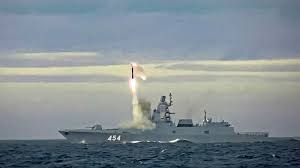Zircon Missile:

Russia recently said that it had fired a Zircon (Tsirkon) hypersonic cruise missile at a target in the Barents Sea.
- The 3M22 Zircon (Tsirkon), NATO code-named SS-N-33, is a scramjet-powered hypersonic cruise missile developed by Russia.
- Initially designed to target naval assets, the missile has evolved to include land-attack capabilities, making it an important tool for precision strike missions.
- It entered service in 2022, with initial deployments on Project 22350 Admiral Gorshkov-class frigates.
- It has an estimated length of 9 meters (30 feet) and a diameter of 60 cm (24 inches), with an estimated weight of between 3,000 and 4,000 kg (3–4 tons).
- The missile is powered by a two-stage propulsion system.
- The first stage consists of a booster engine powered by solid fuel, which accelerates the missile to supersonic speeds.
- After reaching a certain speed, the scramjet engine in the second stage ignites, utilizing liquid fuel to accelerate the missile to hypersonic speeds.
- Its speed—reaching up to Mach 9—makes it extremely difficult to intercept.
- The operational range of the Zircon is reported to be around 400–450 km (250–280 miles) at low altitudes, while it can extend up to 1,000 km (620 miles) in a semi-ballistic trajectory.
- It is capable of carrying both conventional and nuclear warheads, providing it with a versatile role in modern warfare.
- The missile uses a combination of inertial navigation, radar homing, and plasma stealth to navigate towards its target.
- One of the key features of the Zircon is its ability to generate a plasma cloud during hypersonic flight, which absorbs radio waves and makes the missile more difficult to detect by radar.
- This phenomenon is known as plasma stealth.




